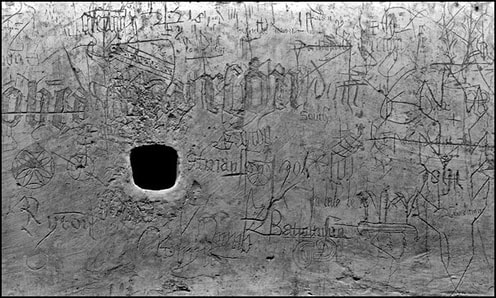Survey module: Church graffiti

s well as being the sites of formal monuments and memorials, the extent of informal writing, carving and drawing in the form of graffiti surviving in our parish churches is becoming increasingly apparent. Sometimes incised on the fabric of the building itself, but also often found on fittings, such as choirstalls and pews, and freestanding and wall mounted memorials , this graffiti can take the form of names, monograms, devotional symbols (crosses; Marian imagery), gaming board and host of other images and designs. They form an important record of the lives and believes of those who worshipped and used our local churches.
Elsewhere, there have been major projects recording and collating examples
of this, most notably the Norfolk Medieval Graffiti project, which has worked successfully with volunteers to develop methodologies for recording this material. The Department of Archaeology Durham University also has particular expertise in developing digital methodologies for recording historic graffiti, developed as part of the major
research project by Dr Pam Graves on the medieval graffiti preserved in the Prior’s Chapel at Durham Cathedral
There are far too many parish churches in the region for the Belief in the North-East project to survey them all, so we will aim to survey at least 10% of them. Using methodologies based on those developed by the Norfolk Medieval Graffiti project and following the Historic England Guidelines on Recording Historic Graffiti, groups of volunteers will be trained in recording methodologies before being allocated groups of churches to investigate and survey. On completion of the survey records and processing of all digital image data copies will be provided to the church communities themselves, as well as being integrated into a formal database.
Do you want to get involved? First watch this video
Elsewhere, there have been major projects recording and collating examples
of this, most notably the Norfolk Medieval Graffiti project, which has worked successfully with volunteers to develop methodologies for recording this material. The Department of Archaeology Durham University also has particular expertise in developing digital methodologies for recording historic graffiti, developed as part of the major
research project by Dr Pam Graves on the medieval graffiti preserved in the Prior’s Chapel at Durham Cathedral
There are far too many parish churches in the region for the Belief in the North-East project to survey them all, so we will aim to survey at least 10% of them. Using methodologies based on those developed by the Norfolk Medieval Graffiti project and following the Historic England Guidelines on Recording Historic Graffiti, groups of volunteers will be trained in recording methodologies before being allocated groups of churches to investigate and survey. On completion of the survey records and processing of all digital image data copies will be provided to the church communities themselves, as well as being integrated into a formal database.
Do you want to get involved? First watch this video
DOWNLOAD KEY RESOURCES
| church_graffiti_handbook__1_.pdf |
| church_graffiti_photo_record.pdf |
| church_graffiti_site_record.pdf |
| church_graffiti_site_record_.docx |
| church_graffiti_photo_record.docx |